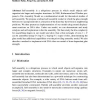Free Online Productivity Tools
i2Speak
i2Symbol
i2OCR
iTex2Img
iWeb2Print
iWeb2Shot
i2Type
iPdf2Split
iPdf2Merge
i2Bopomofo
i2Arabic
i2Style
i2Image
i2PDF
iLatex2Rtf
Sci2ools
89
Voted
DNA
2005
Springer
2005
Springer
A Self-assembly Model of Time-Dependent Glue Strength
Abstract Self-assembly is a ubiquitous process in which small objects selforganize into larger and complex structures. In 2000, Rothemund and Winfree proposed a Tile Assembly Model as a mathematical model for theoretical studies of self-assembly. We propose a refined self-assembly model in which the glue strength between two juxtaposed tiles is a function of the time they have been in neighboring positions. We then present an implementation of our model using strand displacement reactions on DNA tiles. Under our model, we can demonstrate and study catalysis and self-replication in the tile assembly. We then study the tile complexity for assembling shapes in our model and show that a thin rectangle of size k × N can be assembled using O((log(N))/loglog(N)) types of tiles, demonstrating the glue model has additional capabilities over the prior tiling assembly model. We also describe a method to implement with DNA tiles our model of time-dependant glue strength.
| Added | 27 Jun 2010 |
| Updated | 27 Jun 2010 |
| Type | Conference |
| Year | 2005 |
| Where | DNA |
| Authors | Sudheer Sahu, Peng Yin, John H. Reif |
Comments (0)

